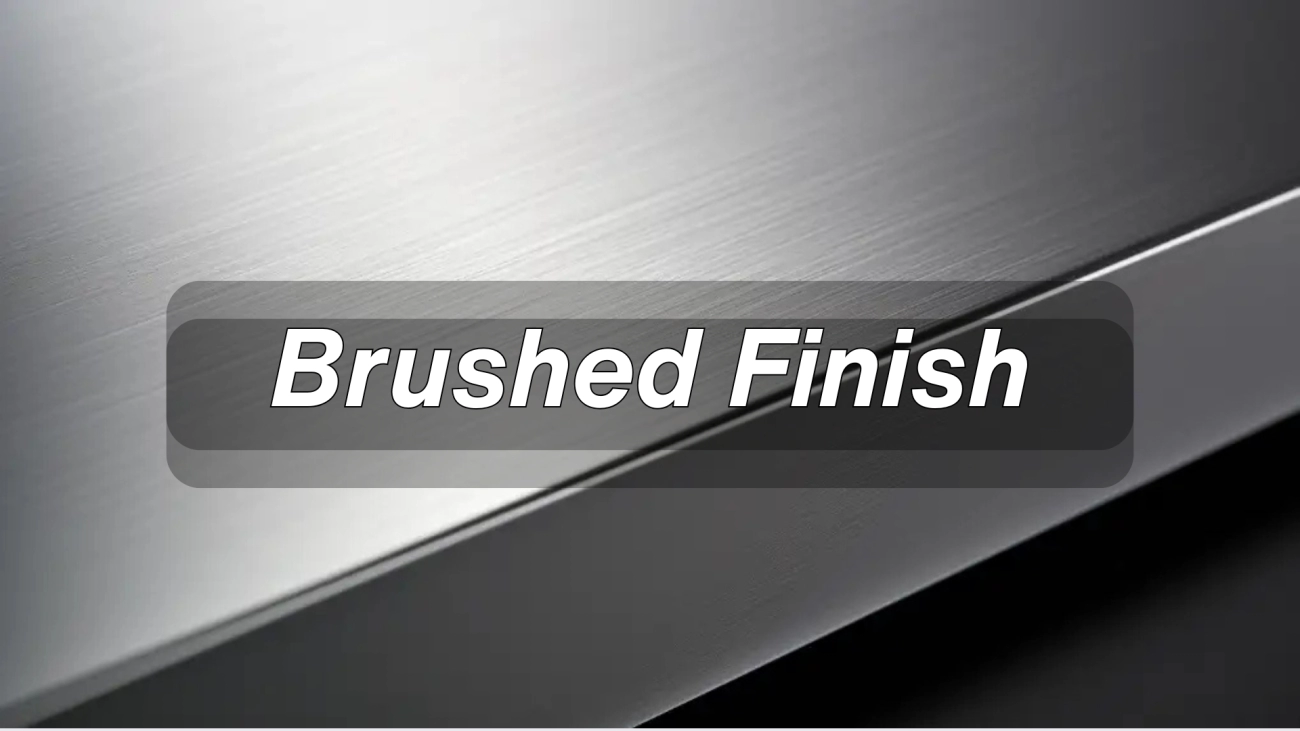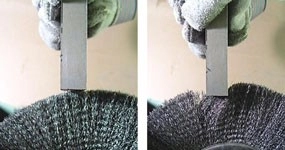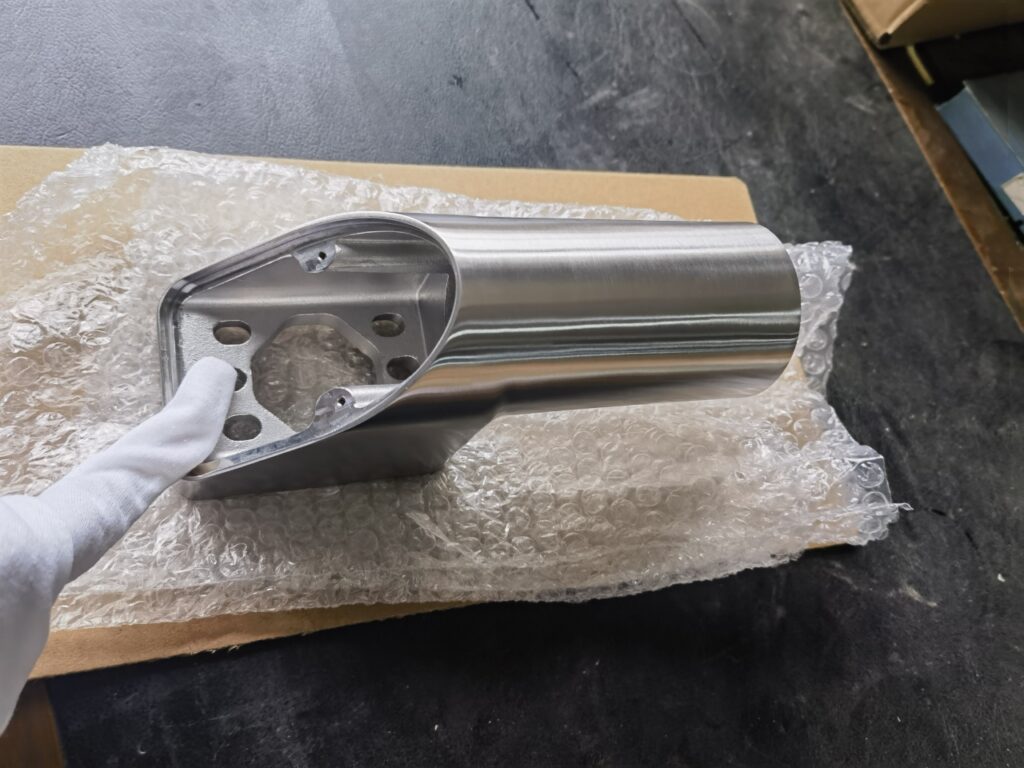Discover expert insights on brushed finishing techniques for metals including stainless steel and aluminum with step-by-step guides and industry tips.
What is Brushed Finishing Defining the Process and Key Characteristics
Have you ever noticed that sleek, textured look on stainless steel appliances or metal fixtures? That’s brushed finishing in action. Brushed finishing is a surface brushing process that gives metal a distinctive, directional grain pattern. Instead of a shiny mirror-like shine, it creates a satin metal texture that feels smooth but shows fine lines running in the same direction.
This finish is known for reducing glare and hiding fingerprints, making it popular for things like kitchen appliances, elevators, and metal trim. The process slightly roughens the metal surface, typically measured by metal surface roughness Ra values, to give it a uniform, matte appearance.
Key characteristics of brushed finishing include:
- Directional grain polishing with fine abrasive brushing tools
- A consistent, uniform texture that’s often called a #4 stainless steel finish in the U.S. market
- Enhanced fingerprint resistance compared to polished or mirror finishes
- Versatility on a variety of metals including stainless steel, aluminum, and brass
In short, brushed finishing balances style and function—offering a modern look while making surfaces easier to maintain. In the next section, we’ll break down the brushed finishing process step by step to show how this look is achieved.
The Brushed Finishing Process Step-by-Step Breakdown

Brushed finishing is all about creating a smooth, consistent texture on metal surfaces. Here’s how the process usually goes, step by step:
- Surface PreparationStart with a clean metal surface. Any dirt, grease, or rust can mess up the finish, so cleaning is key before you begin brushing.
- Choosing the Right Abrasive ToolSelect an abrasive brushing tool based on the desired texture. Common choices include abrasive pads, wire brushes, or sanding belts that help create the signature directional grain polishing.
- Brushing the SurfaceUse the abrasive tool to rub the metal in a single direction, creating fine, parallel lines. This step controls the surface roughness Ra, giving the metal that classic satin metal texture.
- Refining the TextureRepeat the brushing process with finer abrasives as needed. For example, moving from a rough to a #4 stainless steel finish brings out a smoother look and improves fingerprint-resistant metal qualities.
- Cleaning After BrushingWipe down the metal to remove any residual particles or dust. A clean surface is essential for applying any protective coatings or for further processing like CNC brushed aluminum parts.
- Optional Finishing TouchesSome projects might require sealing or coating to protect the brushed finish and keep it looking fresh longer.
This surface brushing process is straightforward but demands attention to detail to achieve that perfect brushed metal finish that looks great and performs well.
Types of Brushed Finishes From 4 to Custom Textures
When it comes to brushed finishing, there’s more than one style to choose from. The most common is the #4 stainless steel finish, known for its clean, uniform satin metal texture. This finish features fine, consistent lines running in the same direction, giving metal surfaces a sleek, fingerprint-resistant look that’s popular in kitchens and appliances.
Beyond #4, there are other popular textures like #3 and #2 finishes, each with different roughness levels and brushing patterns. While #3 is rougher with a coarser grain, #2 is even more textured, making them suitable for heavy-duty or industrial applications.
For those who need something unique, custom brushed finishes can be crafted to fit specific design goals or functional needs. These custom textures can vary from ultra-fine directional grain polishing to more artistic, random brushing styles, tailored by changing abrasive grades or brushing angles.
Whether it’s CNC brushed aluminum or brushed metal finish on stainless steel, the choice depends on the look and feel you want, along with how much surface roughness (Ra) is acceptable for your project. This flexibility makes brushed finishing a favorite across industries, combining style with practicality.
Best Materials for Brushed Finishing and Compatibility Factors

Brushed finishing works best on metals that respond well to abrasive brushing tools and directional grain polishing. The most common materials include stainless steel, aluminum, and brass.
- Stainless Steel: The #4 stainless steel finish is a popular choice because it takes the brushing process well, creating a smooth satin metal texture that resists fingerprints and hides scratches effectively. It’s widely used in kitchen appliances and architectural elements in the U.S. market.
- Aluminum: CNC brushed aluminum offers a lightweight option with excellent corrosion resistance. It pairs well with brushed finishes to create a modern look with visible but subtle directional brush marks.
- Brass and Copper: These metals gain an attractive warm hue through surface brushing. They develop a unique patina over time but need protective coatings to maintain the brushed appearance.
- Compatibility Factors: When choosing materials for brushed finishing, consider metal thickness, surface hardness, and roughness (Ra). Softer metals may require gentler brushing to avoid damage, while harder metals can handle more aggressive surface brushing.
Selecting the right material impacts the final look and durability of the brushed metal finish, ensuring it fits with your project’s practical needs and aesthetic goals.
Tools and Equipment Selecting the Right Abrasives for Precision
Choosing the right tools and abrasives is key to getting a consistent brushed finishing look. Whether you’re working with stainless steel, aluminum, or another metal, the right abrasive brushing tools make all the difference.
For most brushed metal finishes, including the popular #4 stainless steel finish, abrasive pads or belts with a medium grit are ideal. These help create that signature directional grain polishing without removing too much material or causing scratches. On the other hand, for finer textures or custom satin metal textures, you might opt for finer grit abrasives to control the metal surface roughness Ra more precisely.
When it comes to equipment, orbital sanders, belt sanders, or CNC brushed aluminum machines can deliver excellent results. CNC machines provide precise control over the brushing pattern, especially useful in large-scale production or when consistent fingerprint-resistant metal surfaces are needed.
Here’s a quick tool checklist for brushed finishing:
- Abrasive pads or belts – Medium or fine grit depending on finish
- Orbital or belt sanders – For hand or machine operation
- CNC brushing systems – For high precision and repeatability
- Clean cloths or brushes – To remove debris during the process
Using the right combination of tools and abrasives helps maintain control over the finish’s direction and texture, ensuring you get a professional, consistent outcome every time.
Benefits of Brushed Finishing Aesthetic and Functional Advantages
Brushed finishing offers a great mix of style and practical benefits, making it popular across many industries in the US. Here’s why it stands out:
Aesthetic Benefits
- Modern look: The directional grain polishing creates a sleek satin metal texture that looks clean and contemporary, perfect for appliances, fixtures, and architectural elements.
- Hides fingerprints and scratches: Compared to polished or mirror finishes, the brushed metal finish is much better at masking fingerprints and minor wear, keeping surfaces looking neat longer.
- Customizable styles: From the common #4 stainless steel finish to unique custom textures, you can tailor the appearance to fit your brand or design needs.
Functional Benefits
- Improved surface durability: The abrasive brushing process slightly roughens the metal surface (measured by metal surface roughness Ra), which can help hide imperfections and resist daily wear.
- Less glare: Unlike glossy finishes, a brushed finish reduces reflection which is easier on the eyes and works well in bright environments.
- Better grip and handling: The texture provides a subtle grip, useful for handles, tools, and other items needing a non-slip surface.
- Versatile on materials: It works great on stainless steel, aluminum (including CNC brushed aluminum), and other metals, offering flexibility across applications.
Choosing brushed finishing not only ups the style factor but also adds practical durability, making it a smart choice for many metal projects in the US market.
Brushed vs Other Finishes Polished Satin and Mirror Comparisons
When choosing a metal finish, it’s important to understand how brushed finishing stacks up against polished, satin, and mirror finishes. Each has a distinct look and feel that fits different needs.
- Brushed FinishThis finish features a directional grain polishing that gives the metal a soft, matte look. It hides fingerprints and scratches better than polished surfaces, making it great for everyday use. The surface brushing process creates a satin metal texture that’s ideal for both aesthetics and practicality.
- Polished FinishPolished metal has a smooth, shiny surface. It reflects light more, giving a bright, glossy look. However, polished finishes show fingerprints and smudges more easily and require more maintenance to keep them clean and shiny.
- Satin FinishSatin finish is somewhat between brushed and polished. It offers a muted shine with a smooth feel but less visible grain. It’s less scratch-resistant than a brushed finish, but more fingerprint-resistant than polished metal.
- Mirror FinishMirror finishes are highly reflective, almost like glass. They require precise polishing and are often more delicate, showing smudges and scratches quickly. They’re stunning visually but aren’t always practical for high-traffic environments.
Table
| Finish Type | Look | Fingerprint Resistance | Scratch Visibility | Maintenance |
|---|---|---|---|---|
| Brushed | Matte, grainy | High | Low | Low |
| Polished | Shiny, reflective | Low | High | High |
| Satin | Soft sheen | Medium | Medium | Medium |
| Mirror | Very reflective | Low | High | High |
For most U.S. customers looking for durability and style, a #4 stainless steel finish or CNC brushed aluminum offers a great balance. It’s fingerprint-resistant and keeps metal surface roughness Ra low, meaning the surface is smooth but without the glare of polished finishes.
If you want expert advice on which finish fits your application best, our team can help you find the right match based on your needs and usage.
Applications Across Industries Real World Use Cases
Brushed finishing is a go-to choice for many industries because it combines style with practicality. Here’s how it’s used across different fields:
- Kitchen Appliances and Cookware: The brushed metal finish, especially the popular #4 stainless steel finish, gives appliances a clean, modern look while hiding fingerprints and scratches. It’s perfect for ovens, refrigerators, and sinks.
- Automotive Industry: From interior trim to exterior details, brushed finishes add a sleek, durable surface that resists wear and keeps vehicles looking sharp longer.
- Architecture and Interior Design: Brushed aluminum and steel panels provide a smooth, satin metal texture that’s ideal for wall cladding, elevator panels, and decorative accents, offering both aesthetic appeal and durability.
- Electronics and Gadgets: Devices often use CNC brushed aluminum for a premium feel and a fingerprint-resistant metal surface, improving usability and style.
- Furniture and Fixtures: Brushed finishes on metal legs, handles, and frames give furniture a subtle, refined look that fits modern decor.
- Industrial Equipment: The surface brushing process reduces metal surface roughness Ra, improving resistance to corrosion and wear, extending equipment lifespans.
These real-world uses prove brushed finishing fits many needs—whether for looks, functionality, or both—making it a solid choice for U.S. businesses looking for reliable, professional metal finishing solutions.
Common Challenges and Pro Tips for Flawless Results
Brushed finishing can look fantastic, but it’s not without its challenges. Here are some common issues you might face and how to avoid them to get that perfect brushed metal finish every time.
Challenges to Watch For
- Uneven Grain Patterns: Inconsistent pressure or wrong abrasive can cause uneven directional grain polishing.
- Over-Brushing: Too much brushing can damage the surface, increasing metal surface roughness Ra beyond desired specs.
- Scratches or Gouges: Aggressive brushing or dirty tools might leave unwanted scratches that are hard to fix.
- Contamination: Dust, grease, or fingerprints can ruin the satin metal texture and cause fingerprint-resistant metal benefits to drop.
- Material Compatibility: Using the wrong brushing method or abrasive on materials like CNC brushed aluminum can lead to discoloration or uneven texture.
Pro Tips for Flawless Brushed Finishing
- Use consistent, even pressure with abrasive brushing tools to maintain smooth, directional grain polishing.
- Start with a lighter grit and gradually go finer to avoid over-brushing.
- Clean the surface and tools thoroughly before starting to prevent contamination.
- Test on a small piece or hidden area to check compatibility, especially when working with #4 stainless steel finish or aluminum.
- Maintain your tools regularly—worn abrasives can cause uneven finishes.
- Work in a dust-free environment to protect the metal surface and keep that fingerprint-resistant metal look strong.
By keeping these challenges and tips in mind, you’ll get a professional brushed finish that looks great and lasts longer.
Maintenance and Care Extending the Life of Your Brushed Finish

Keeping your brushed finishing looking sharp is easier than you might think. Regular maintenance helps protect that satin metal texture and keeps fingerprints and smudges at bay, especially on brushed metal finish surfaces like stainless steel or aluminum.
Here’s how to extend the life of your brushed finish:
- Clean Gently and Regularly: Use a soft cloth with mild soap and warm water to wipe down the surface. Avoid harsh chemicals or abrasive cleaners that can damage the directional grain polishing.
- Avoid Scratches: Even though brushed finishes hide scratches better than polished ones, rough scrubbing or dull abrasive tools can ruin the surface brushing process effect. Use non-abrasive sponges or microfiber cloths instead.
- Dry Immediately: After cleaning, dry the surface to prevent water spots and reduce metal surface roughness Ra changes caused by moisture.
- Use Protective Coatings: For fingerprint-resistant metal surfaces, consider applying a clear sealant to help reduce smudging and make future cleaning easier.
- Routine Inspections: Check regularly for any signs of wear or staining and address them early to avoid deep damage.
Keeping these simple steps in mind helps your brushed finish look fresh, professional, and durable for years. Whether it’s #4 stainless steel finish or CNC brushed aluminum, proper care makes a noticeable difference.
Partner with VastPCC for Expert Brushed Finishing Services
When it comes to brushed finishing, partnering with VastPCC guarantees top-quality results you can trust. We specialize in delivering precise brushed metal finishes, including popular options like the #4 stainless steel finish and custom satin metal textures. Our China brushed finishing factory uses advanced abrasive brushing tools and CNC brushed aluminum tech to ensure consistency and attention to detail.
Choosing VastPCC means you get:
- Consistent directional grain polishing for a smooth, fingerprint-resistant metal surface
- Expert handling of surface brushing process to meet your exact metal surface roughness Ra requirements
- Quick turnaround and scalable production ideal for both small projects and large industrial orders
- Customized brushed finishes tailored to your sector, whether construction, automotive, or consumer goods
We understand the needs of US customers for durable, aesthetic, and functional brushed finishes. Reach out to VastPCC today to elevate your metal products with our expert brushed finishing services.

